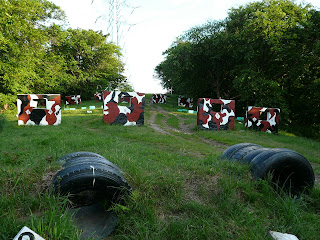 Molun-dae south of Busan city where the Nakdong river meets the sea. The couple below are picnicing in a military foxhole, one of dozens on the rocks.
Molun-dae south of Busan city where the Nakdong river meets the sea. The couple below are picnicing in a military foxhole, one of dozens on the rocks. Mike at Molun-dae.
Mike at Molun-dae.Leaving from the point of Molun-dae Mike and I headed north along the ridge to the west of Downtown Busan, heading over the small peaks of Ami-san and Bonghwa-san in our first afternoon.
It didn't take long before we realised that our goal of reaching Nopo-dong some 50km north by weekends end was going to be an ambitious one as we ran into suburban Busan shortly after exiting the park at Molun-dae.
Busan is a major city, easily the second largest in Korea, and we had to navigate our way through city streets and apartment blocks at every pass. This was a difficult and time-consuming exercise but worth it every time we found the forested trail entrance, ribboned by past walkers as on the Baekdu-daegan ( this time 낙동정맥), leading back into the hills.
 Dadae-po beach is formed of sediment from the Nakdong river and connects the peninsula with Molun-dae, which was once an island.
Dadae-po beach is formed of sediment from the Nakdong river and connects the peninsula with Molun-dae, which was once an island.Our first navigational challenge, the newly constructed and simply enormous "Lotte Castle" apartment complex on the hills behind Molun-dae. My mate Jun in Daegu lives in a Lotte Castle and they're pretty flash, he can turn on the taps with his foot when doing the dishes and there's a TV on his toilet roll holder. The grounds of the apartment probably cover 100acres and it took a good half-hour before we found the continuation of the trail behind building 201.
And west, the mouth of the Nakdong River
 The small temple Seorim-sa (서림사) on the trail below Ami-san has some interesting paintings in it's shrines and an awesome vege garden.
The small temple Seorim-sa (서림사) on the trail below Ami-san has some interesting paintings in it's shrines and an awesome vege garden. San-shin, the Mountain Spirit of Korea's shamanistic religion, sitting as always with a tiger under a pine tree in the San-shin gak (mountain spirit shrine) at Seorim-sa.
San-shin, the Mountain Spirit of Korea's shamanistic religion, sitting as always with a tiger under a pine tree in the San-shin gak (mountain spirit shrine) at Seorim-sa. Our second, and in the end most time consuming urban river, Jeongmil-gogae pass connecting Ami-san to Bongwha-san.
Our second, and in the end most time consuming urban river, Jeongmil-gogae pass connecting Ami-san to Bongwha-san. The hills above Gupyeong-dong overlook the busy Gamcheon harbour and are dominated by a large military facility which the trail follows along the ridge.
The hills above Gupyeong-dong overlook the busy Gamcheon harbour and are dominated by a large military facility which the trail follows along the ridge. "The Kennedy Rose" bar and grill. Strategically placed right on the trail, we walked in the doors just on dark after searching for some time for the next trail entrance. This photo is of course taken in the brilliant sunshine of next morning...
"The Kennedy Rose" bar and grill. Strategically placed right on the trail, we walked in the doors just on dark after searching for some time for the next trail entrance. This photo is of course taken in the brilliant sunshine of next morning... Gamcheon harbour.
Gamcheon harbour. Guengak-am (극락암) temple above the Dongju area
Guengak-am (극락암) temple above the Dongju area San-shin shrine at Geungak temple
San-shin shrine at Geungak temple Heading down toward the Daeti tunnell, if you've been there before you'll realise we're going the wrong way.
Heading down toward the Daeti tunnell, if you've been there before you'll realise we're going the wrong way. The trail up to Siyeok-san and Gudeok-san
The trail up to Siyeok-san and Gudeok-san On Siyeok-san, with the Gudeok stadium below.
On Siyeok-san, with the Gudeok stadium below.



















2 comments:
G'day douchy. Nice job and cool photos. I like the one of the dog. Mate, were there ever any nakdong ribbons in the 'urban-rivers' as you put them, espicially in those narrow alley-ways on the fringes of the ridge?
bawisansaram.
Hey bro. There were ribbons occasionally but only in the forested areas of the trail, the "urban rivers" were unmarked.
I'm pleased to say though we didnt cross water at any time so didn't get too far off course.
Post a Comment